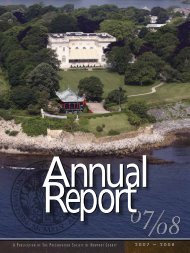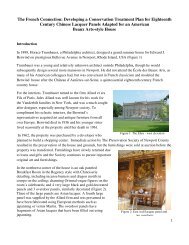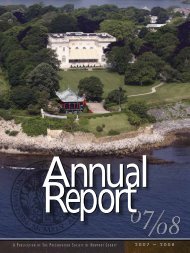FROM MEDICI TO BOURBON - Newport Mansions
FROM MEDICI TO BOURBON - Newport Mansions
FROM MEDICI TO BOURBON - Newport Mansions
Create successful ePaper yourself
Turn your PDF publications into a flip-book with our unique Google optimized e-Paper software.
Chapter 2: In Search of Taste<br />
William Henry Vanderbilt’s 1885 will arranged for a modified primogeniture<br />
for the third generation males. Eldest sons Cornelius Vanderbilt II (1843-1899) and<br />
William K. Vanderbilt (1849-1920) received the largest portion of the $200 million<br />
estate, each being given over $50 million each. 54 The equal distribution of wealth<br />
between the elder brothers was recognized as being a reward for the junior daughter-<br />
in-law, Mrs. William K. Vanderbilt’s successful campaign to launch the family into<br />
the select inner circle of New York society. Key to this perception was her<br />
motivating role in the construction of the elder brothers’ own Fifth Avenue<br />
residences, contemporary with their father’s, and built between 1878 and 1883 with<br />
the fruits of the Commodore, their grandfather’s, bequest. These highly visible<br />
townhouses quickly realized Mrs. William K. Vanderbilt’s Medicean prophecy. By<br />
1892 the economist George Gunton claimed that the Vanderbilt mansions led to a new<br />
direction of devoting American wealth to the uplifting of the national standard of taste<br />
and social distinction. 55 Gunton beheld in such ostentation the promise for America<br />
of entering upon the threshold of the ‘leisured phase of its societary development’. 56<br />
William and Alva Vanderbilt were first to answer the call by erecting, at 660<br />
Fifth Avenue, a then unique in America, urban, limestone-clad, château de la Loire,<br />
designed by the socially prominent gentleman-architect Richard Morris Hunt (1827-<br />
54 Four daughters (Margaret, Emily, Florence and Eliza) and two younger sons (Frederick and George)<br />
received the houses they lived in, $5 million each and one-eighth of the annual income on an additional<br />
$40 million in trust for life.<br />
55 Simon Bronner, ‘Reading Consumer Consumption’ in Consuming Visions: Accumulation and<br />
Display of Goods in America, 1880-1920, ED. Simon Bronner, New York, 1989, p. 23.<br />
56 Ibid, p. 23.<br />
14





